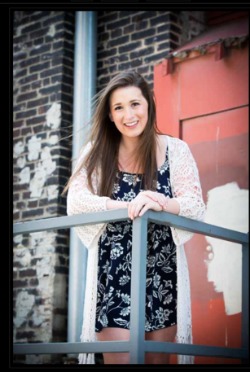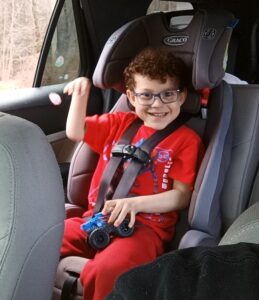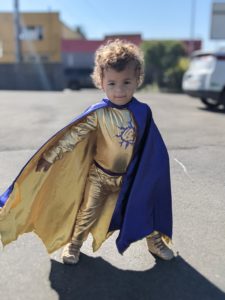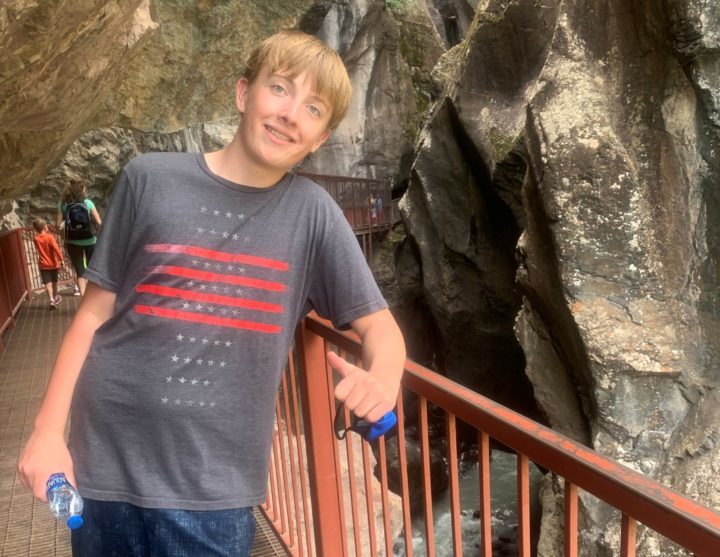Meet Blake — Stroke at age 16
Blake Ephraim tragically lost her battle with seizures in July 2018. She was only 21. Blake was a powerful advocate for pediatric stroke and traumatic brain injury patients. The world is a better place because of Blake and her story will continue to inspire others for years to come. Young advocate for stroke victims remembered as ‘tsunami’ ahead of memorial in Overland Park
Blake submitted this story to us in 2016.
On Friday, November 1, 2013, I awoke with ear pain but went to school. Shortly after first period started, I told my teacher I didn’t feel well and needed to see the nurse. The next thing I knew, my friend woke me up and said it was lunch time. I called my mom and she met me at the pediatrician’s office. The doctor said it was probably the beginning of a cold and with a few medications, I would be okay. I went back to school, cheered at the football game, and made it back home. My head was pounding and I just wanted my bed. I remember getting sick a few times in the middle of the night and waking up with my head still hurting. I laid in bed most of the day, but by 4pm, I felt good enough to get up and get ready for my competitive cheer teams “parent show-off”. With competition season just three weeks away, we were performing our routines for family and friends. I didn’t feel great and told my coach but as we all know, if one person can’t perform, the whole team can’t perform. I went on and we did it: the routine looked great and we were almost ready for our first competition. When it was over, I found my mom and she knew it was time to go back home.
Several hours later, the pain was excruciating, I was crying hysterically and I wanted to be sick. My mom was lying next to me trying to console and comfort me. My step-dad came in and said it was time to go to the hospital. I made it downstairs and wanted to be sick again. My step-dad was next to me telling me to get on my knees but I couldn’t understand what my knees were and how to bend down. I remember walking into the emergency room and being led to a hospital bed. The nurse gave me some medicine and that is the last I remember until waking up in my hospital ICU room.
My mom reviewed the days leading up to my stroke and explained I had been rushed to the hospital that Saturday night and then on Sunday morning, an angiogram and MRI confirmed that I had a hemorrhagic and ischemic stroke. The stroke team determined cerebral venous sinus thrombosis (CVST), a rare condition most often seen in young adults, caused my stroke. CVST requires a high degree of expertise to diagnose and treat. On Monday, November 4th, the doctors performed an emergency decompressive craniotomy to remove part of my skull, allowing my brain to continue to swell and slowing the degree of damage. The medical team kept me sedated for several days, only pausing the medication long enough for them to ask me to raise my left leg, my left arm, my right leg and right arm. It had been a frightening week for my family and friends. As my mom continued to share the details of the last two weeks, I sat in disbelief. I was scared, confused, and sad. I made her tell me the story over and over again.
I spent the next three weeks at the Madonna Rehabilitation Hospital in Lincoln, Nebraska. I had physical, occupational and speech therapy twice a day. Physically, I could feel my body getting stronger but mentally I was so sad. I had been smart, now I wasn’t. Why couldn’t I read simple words, why couldn’t I say simple things, and why am I so far away from home? My team of therapist were great, they believed in me and encouraged me every step of the way. Once I could finally grasp what had happened and that I was in control of my recovery, I found the strength to do what was necessary to begin my journey back. We had a target date, I wanted to be released from Madonna on December 6th so I could attend competition for both my high school and competitive cheer teams on December 7th.
Mission accomplished! My mom and I left Madonna on Friday morning and I surprised my high school squad on Friday during practice. It was one of the best moments I could remember. I missed my friends so much and I missed being with them each day getting ready for competition. On Saturday morning, my family and I surprised my competitive team and arrived in time for me to walk out on the mat for their performance. It was a great moment, walking hand-in-hand with my team who loved and supported me through the last five weeks. Later that afternoon, I walked out on the mat with high school squad as they competed and took top honors.
Soon winter break was over, I had surgery to replace the piece of skull that had been removed, and plans had been made for me to return to school. I was apprehensive, nervous and excited to return to school. I wasn’t excited about the classes I was going to have to take, I just wanted to be normal. I wanted to be who I was before the stroke, I wanted my old life back. Once again, I had an incredible group of people to support me through the next semester. The best way I can explain it is this: I started that semester at a 4th grade reading level and with a lot of hard work and determination, I was back on grade level by May.
Today, I am finishing my freshman year at Pittsburg State University and while I am proud of my accomplishments, I continue to face the challenges resulting from my stroke. I have become an advocate for stroke awareness and someday hope to help others through the maze of recovery. We are B.E. Strong! A slogan created my cheer coach at KGDC and a chant heard for many months during my recovery. B.E. (my initials) and Strong – Strength, Tenacity, Resolve, Optimistic, Never Quit, and Giving, all adjectives that describe me and traits every survivor needs during recovery. My passion is to help and educate others about stroke and brain injury has led my family to create the B.E. Strong Foundation, Hope after Stroke and Brain Injury. I have met other stroke survivors who inspire me and one day, I hope to be very involved in the education of stroke awareness, its effects on both the survivor and their families and, most importantly, stroke recovery.




